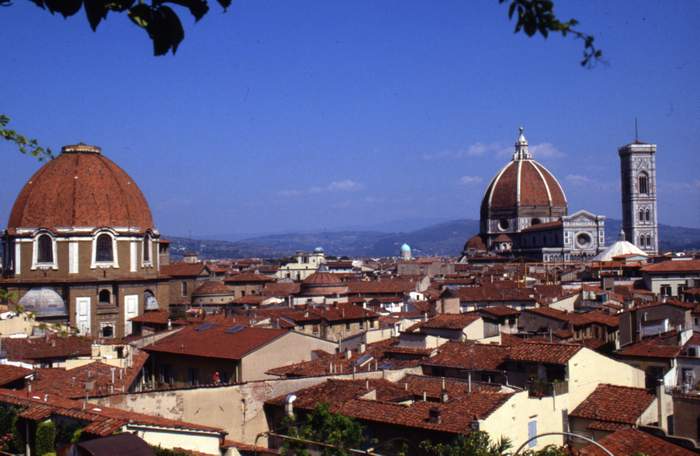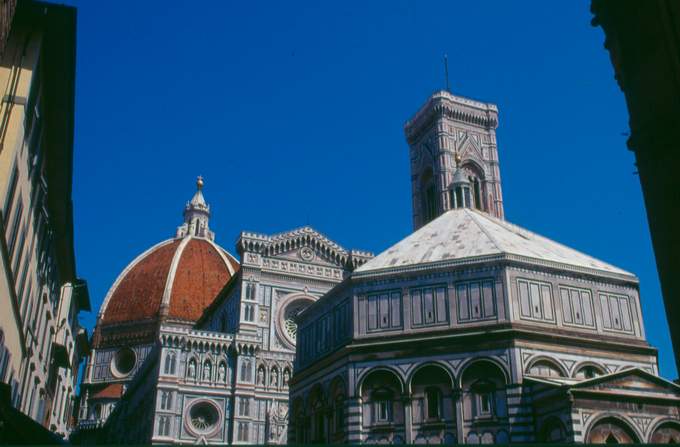|
"Florentia", the florid, was the name given by the Romans to this small settlement located at the foot of the ancient Etruscan Fiesole and founded in the first century b.C. The Etruscans, an ancient and mysterious race, of whom we know very little, but who left numerous testimonies around about Florence, had settled on the hills surrounding the plain of the river Arno as far back as the VII-VI centuries BC.  At first erected as a Roman "castrum", Florentia soon assumed the appearance of a real town with a Forum (now Piazza della Repubblica), thermal baths (via delle Terme), and amphitheater (via Tòrta). At first erected as a Roman "castrum", Florentia soon assumed the appearance of a real town with a Forum (now Piazza della Repubblica), thermal baths (via delle Terme), and amphitheater (via Tòrta). 
Then the period of the decline of the Empire arrived , with the political fragmentation from which the feudal system sprang up. The town, constituted as a Commune at the beginning of the twelfth century, began to expand until it spread over half of Arno valley and surrounding hillsides.
Despite the internal struggles, first between rival families and then between the Guelfs (loyal to the Pope) and the Ghibellines (loyal to the Emperor), from the thirteenth century onwards it began to flourish as a city of art, culture and international trading, reaching its zenith in the fifteenth century under the Signoria of Cosimo and Lorenzo de’ Medici. After Lorenzo’s death in 1492, Florence witnessed a long period of wars that led to the end of the Florentine Republic and saw the birth of the Grand Duchy of Tuscany, ruled first by a younger branch of the Medici family and following, by the Hapsburg-Lorena family. Despite alternating events the Grand Duchy survived up until the political unification of Italy, of which Florence was capital from 1865 to 1871.
This marked the beginning of a profound restructuring of the city that led to the knocking down of the walls and the erasing of several ancient quarters in the center that endowed Florence with its present-day appearance.
ART AND MONUMENTS: Many visits in Florence and its province discovering the city of Dante, Brunelleschi and the rich patrimony of art and nature.
One of the mail point of interest is Church and Museum of Santa Maria Novella, the church was begun in 1278 for Dominican friars, ande it was completed in 1360. The white and green marble Gothic-Romanesque façade was completed by Leon Battista Alberti who designed the upper part. Inside the church there are splendid masterpieces including "The Trinity" by Masaccio, frescoes by Filippino Lippi and Ghirlandaio in the Tornabuoni chapel, a Crucifix by Giotto and a wooden Crucifix by Brunelleschi. The Museo di Santa Maria Novella is adjacent to the church. Here you can admire the splendid Green Cloister frescoed by Paolo Uccello and his school. In the Chapter Room, known as the "Cappellone degli Spagnoli" is a famous fresco by Bonaiuto. Just a short distance from the church is the Officina Profumo Farmaceutica di Santa Maria Novella, where perfumes, soaps and fragrances are made and sold in a Neogothic setting.
Going on we find Marino Marini Museum into the deconsecrated church of Saint Pancrazio houses the museum is dedicated to Marino Marini, one of the foremost 20th century Italian sculptors. Near the museum, in the Rucellai Chapel is the extraordinary Temple of the Holy Sepulchre by Leon Battista Alberti.
You have also to visit Palazzo Vecchio, in Piazza della Signoria: it is the most important civil building in the city; construction, to plans by Arnolfo di Cambio, was begun in 1299. It was the seat of the Priori delle Arti, of the Signoria and the ducal residence; over the centuries it was remodelled several times. The 14th century courtyard, graced with the fountain with the "putto", a copy of Verrocchio's original, was later modified by Michelozzo. Inside, it is worth seeing the Salone dei Cinquecento, the study of Francesco I, the room of the Elements and the Sala dei Gigli. The Loggia della Signoria or "dei Lanzi" overlooks the square; here there are several important statues including "Perseus" by Cellini and the "Rape of the Sabine Women" by Giambologna.
Worlwide known is the Uffizi Gallery that's one of the greatest museums in Italy and the world. It was founded in 1581 by Francesco I de' Medici, who collected numerous artworks in the building designed by Vasari. Today the Uffizi contains masterpieces by Italian and foreign artists from 13th to 18th century such as Cimabue, Giotto, Masaccio, Beato Angelico, Leonardo da Vinci, Botticelli, Michelangelo, Piero della Francesca, Raphael, Caravaggio, along with Rubens, Rembrandt, Dürer, Goya and many others. The Vasari Corridor that connects the Uffizi Gallery with the Pitti Palace hosts a rich collection of self-portraits by past and present artists. Built by Vasari in 1565, it passes above the Ponte Vecchio, the oldest bridge in the city, with its many jewelry shops.
Beautiful are also Cathedral, Baptistery and the Museo dell'Opera del Duomo: Santa Maria del Fiore, the Gothic cathedral erected over the ancient basilica of Santa Reparata, was designed by Arnolfo di Cambio who began construction in 1296. Brunelleschi completed it in 1436 with the elegant dome, the inside of which was entirely frescoed by Vasari and Zuccari. The final phase in the construction of the cathedral, that is the completion of the façade, dates from the mid-19th century. To the right of the cathedral rises the Bell Tower, or Campanile, designed by Giotto in 1334. The square tower is covered with red, green and white marble inlays, decorated with panels and carvings, and made graceful by double- and triple-windows. Opposite the Cathedral stands the green and white marble Baptistery of San Giovanni (1128), a masterpiece of Florentine Romanesque architecture. The interior of the dome is decorated with mosaics. The splendid bronze doors (including the Door of Paradise) were made by Andrea Pisano and Lorenzo Ghiberti.
The Museo dell'Opera del Duomo houses artworks from Santa Maria del Fiore, the Baptistery and the Campanile, including sculptures that had been made for the cathedral façade. The most important works in the museum are by Michelangelo ("Pietà"), Donatello ("Mary Magdalen", "Cantoria"), Arnolfo di Cambio ("Boniface VIII"), Luca della Robbia ("Cantoria").
GASTRONOMY: Florentine cuisine remains the guardian of a great tradition consisting of simple dishes, often prepared with humble, genuine ingredients like bread, oil and vegetables. However, it does not lack in elaborate and imaginative recipes, like the meats prepared in dolceforte, reminiscent of the splendor and eccentricity of the renaissance courts when the aim was more to amaze the guests than to satisfy the palate; between the great variety of recipes we remember: Minestra di Pane e ribollita, il Baccalà alla Fiorentina, la famosa Bistecca alla Fiorentina, i Crostini di Fegatini and after all Castagnaccio.
TEXTS AND PICTURES ARE PROPERTY OF FLORENCE'S TURIST AGENCY. |



 Munch: The Scream Within
Munch: The Scream Within In the garden
In the garden Perugia Travel Guide
Perugia Travel Guide


 At first erected as a Roman "castrum", Florentia soon assumed the appearance of a real town with a Forum (now Piazza della Repubblica), thermal baths (via delle Terme), and amphitheater (via Tòrta).
At first erected as a Roman "castrum", Florentia soon assumed the appearance of a real town with a Forum (now Piazza della Repubblica), thermal baths (via delle Terme), and amphitheater (via Tòrta). 
